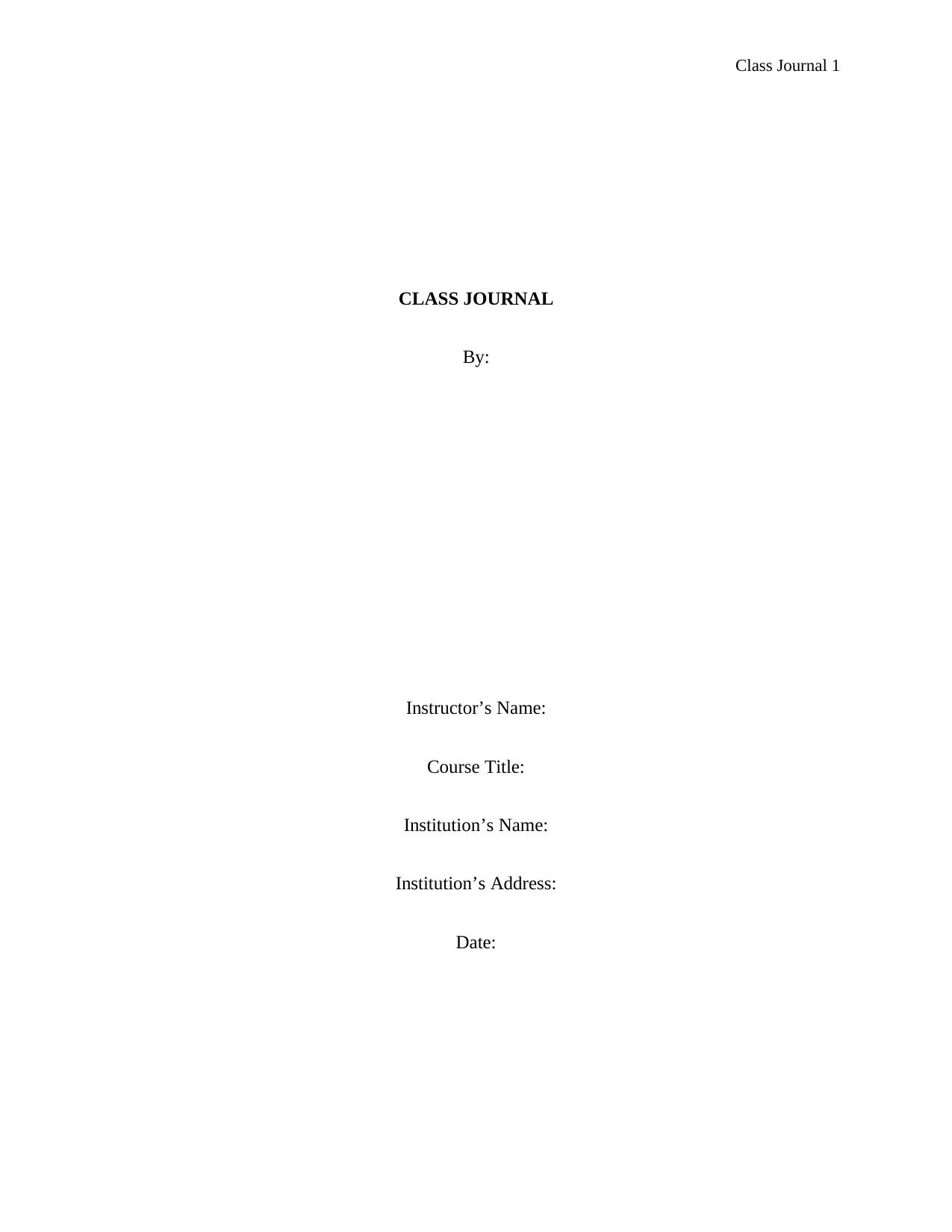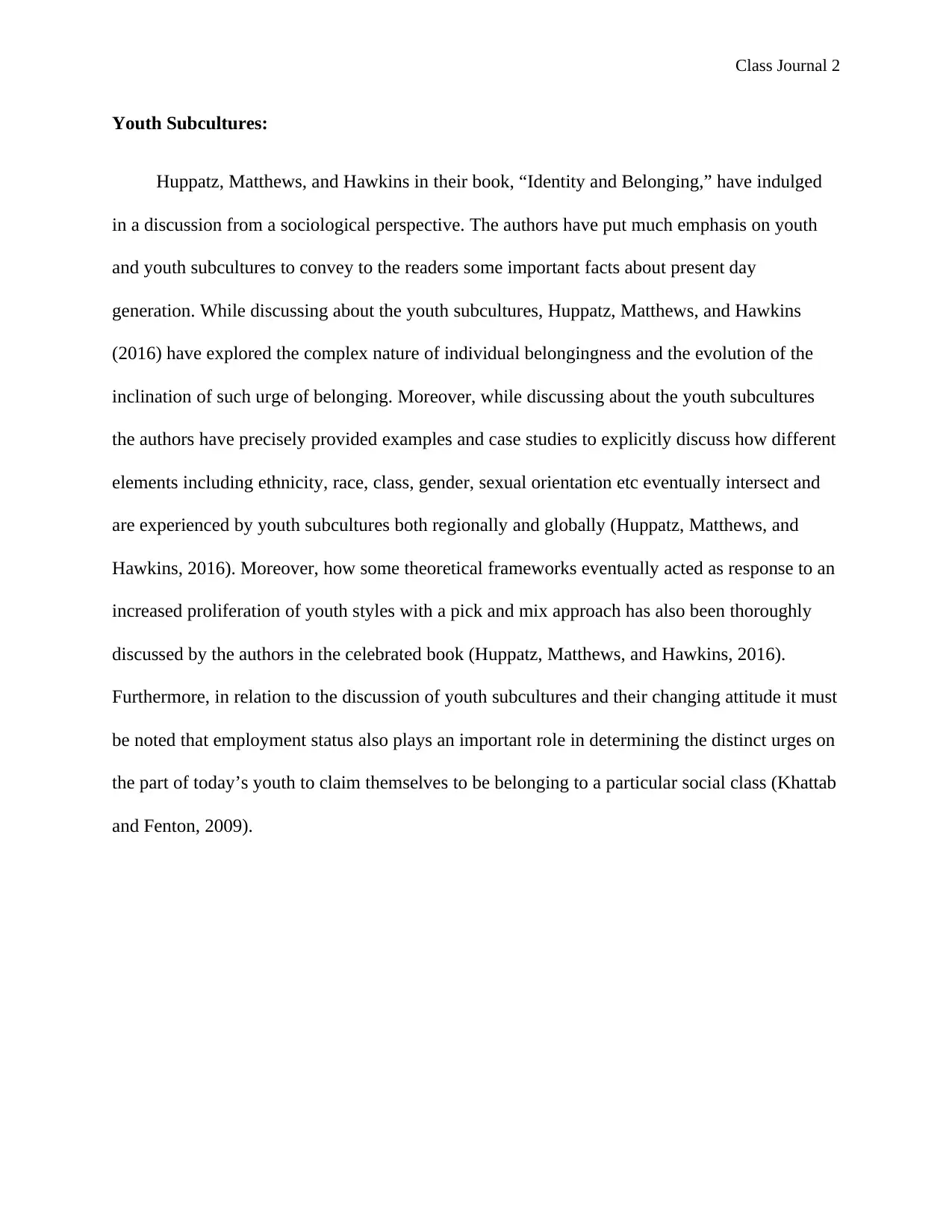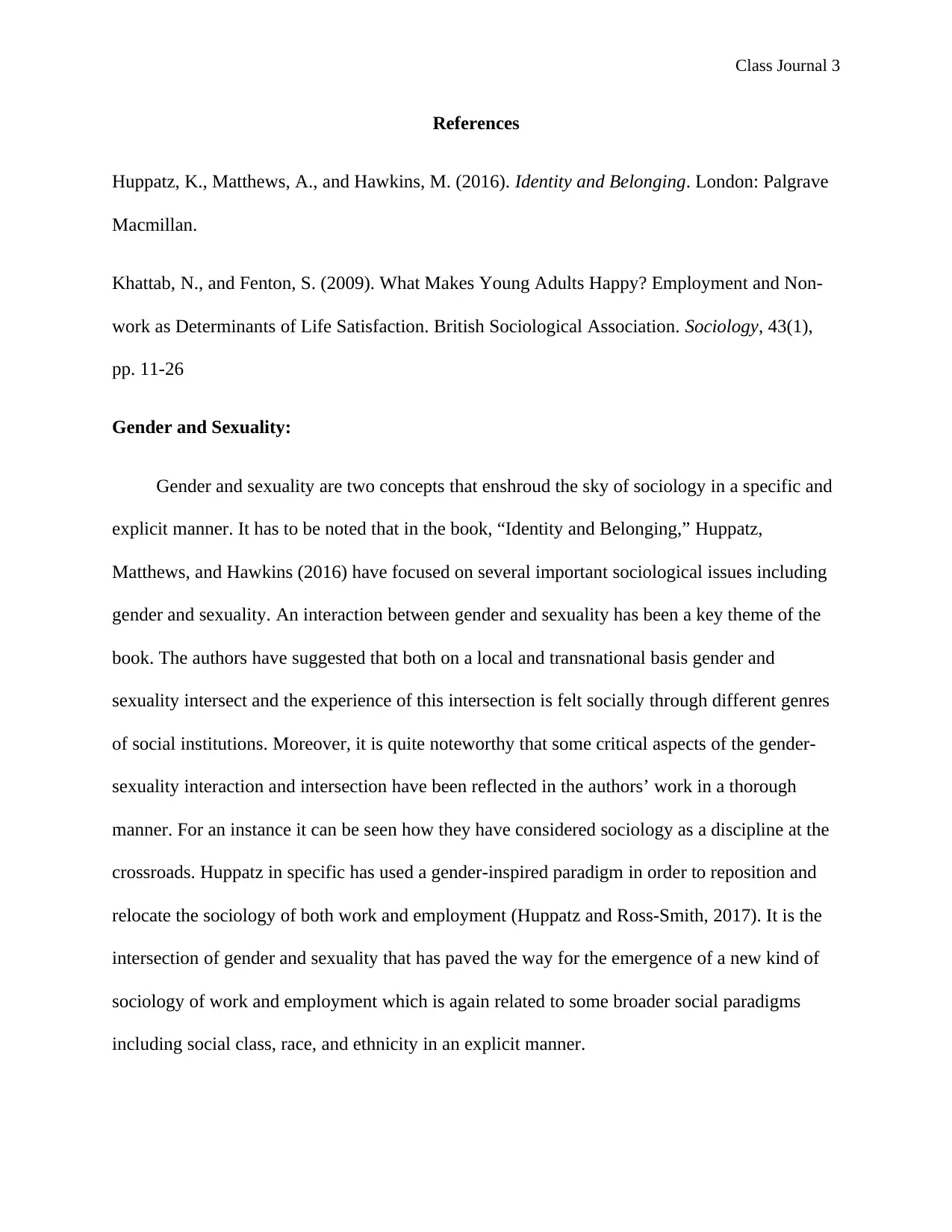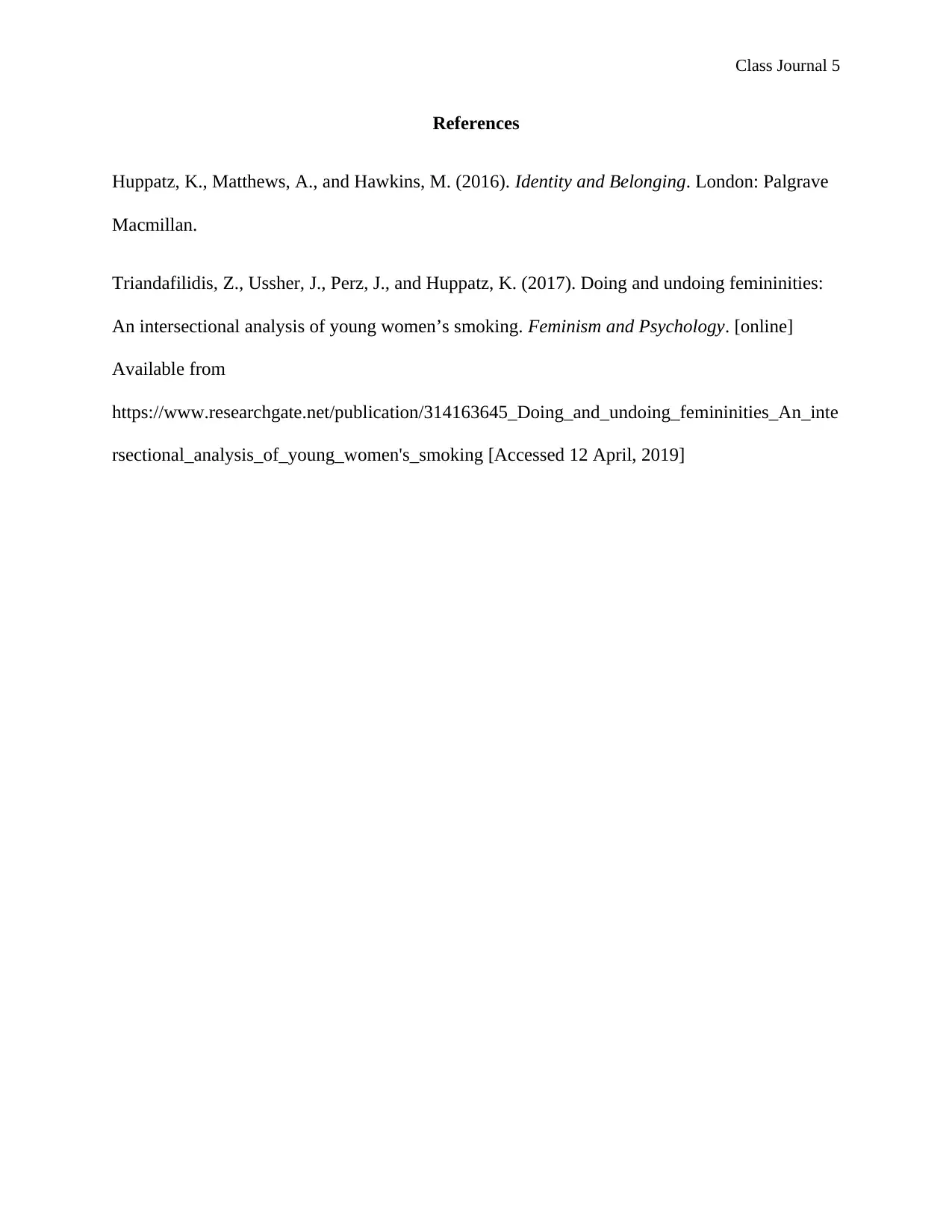Identity & Belonging: Class Journal on Youth, Gender & Consumption
VerifiedAdded on 2023/04/20
|5
|972
|448
Journal and Reflective Writing
AI Summary
This assignment comprises a class journal focusing on sociological perspectives of youth subcultures, gender and sexuality, and consumption, drawing primarily from Huppatz, Matthews, and Hawkins' "Identity and Belonging." The journal entries delve into the complexities of youth identity and belonging, exploring how factors like ethnicity, race, class, and gender intersect within youth subcultures. It further examines the interplay between gender and sexuality, highlighting their impact on social institutions and the sociology of work. The journal also addresses the relationship between consumption, gender roles, and globalization, noting how the urge to belong and conform drives consumption patterns, with references to studies on gender and consumer behavior. This document provides a concise overview of these interconnected sociological themes.

Class Journal 1
CLASS JOURNAL
By:
Instructor’s Name:
Course Title:
Institution’s Name:
Institution’s Address:
Date:
CLASS JOURNAL
By:
Instructor’s Name:
Course Title:
Institution’s Name:
Institution’s Address:
Date:
Paraphrase This Document
Need a fresh take? Get an instant paraphrase of this document with our AI Paraphraser

Class Journal 2
Youth Subcultures:
Huppatz, Matthews, and Hawkins in their book, “Identity and Belonging,” have indulged
in a discussion from a sociological perspective. The authors have put much emphasis on youth
and youth subcultures to convey to the readers some important facts about present day
generation. While discussing about the youth subcultures, Huppatz, Matthews, and Hawkins
(2016) have explored the complex nature of individual belongingness and the evolution of the
inclination of such urge of belonging. Moreover, while discussing about the youth subcultures
the authors have precisely provided examples and case studies to explicitly discuss how different
elements including ethnicity, race, class, gender, sexual orientation etc eventually intersect and
are experienced by youth subcultures both regionally and globally (Huppatz, Matthews, and
Hawkins, 2016). Moreover, how some theoretical frameworks eventually acted as response to an
increased proliferation of youth styles with a pick and mix approach has also been thoroughly
discussed by the authors in the celebrated book (Huppatz, Matthews, and Hawkins, 2016).
Furthermore, in relation to the discussion of youth subcultures and their changing attitude it must
be noted that employment status also plays an important role in determining the distinct urges on
the part of today’s youth to claim themselves to be belonging to a particular social class (Khattab
and Fenton, 2009).
Youth Subcultures:
Huppatz, Matthews, and Hawkins in their book, “Identity and Belonging,” have indulged
in a discussion from a sociological perspective. The authors have put much emphasis on youth
and youth subcultures to convey to the readers some important facts about present day
generation. While discussing about the youth subcultures, Huppatz, Matthews, and Hawkins
(2016) have explored the complex nature of individual belongingness and the evolution of the
inclination of such urge of belonging. Moreover, while discussing about the youth subcultures
the authors have precisely provided examples and case studies to explicitly discuss how different
elements including ethnicity, race, class, gender, sexual orientation etc eventually intersect and
are experienced by youth subcultures both regionally and globally (Huppatz, Matthews, and
Hawkins, 2016). Moreover, how some theoretical frameworks eventually acted as response to an
increased proliferation of youth styles with a pick and mix approach has also been thoroughly
discussed by the authors in the celebrated book (Huppatz, Matthews, and Hawkins, 2016).
Furthermore, in relation to the discussion of youth subcultures and their changing attitude it must
be noted that employment status also plays an important role in determining the distinct urges on
the part of today’s youth to claim themselves to be belonging to a particular social class (Khattab
and Fenton, 2009).

Class Journal 3
References
Huppatz, K., Matthews, A., and Hawkins, M. (2016). Identity and Belonging. London: Palgrave
Macmillan.
Khattab, N., and Fenton, S. (2009). What Makes Young Adults Happy? Employment and Non-
work as Determinants of Life Satisfaction. British Sociological Association. Sociology, 43(1),
pp. 11-26
Gender and Sexuality:
Gender and sexuality are two concepts that enshroud the sky of sociology in a specific and
explicit manner. It has to be noted that in the book, “Identity and Belonging,” Huppatz,
Matthews, and Hawkins (2016) have focused on several important sociological issues including
gender and sexuality. An interaction between gender and sexuality has been a key theme of the
book. The authors have suggested that both on a local and transnational basis gender and
sexuality intersect and the experience of this intersection is felt socially through different genres
of social institutions. Moreover, it is quite noteworthy that some critical aspects of the gender-
sexuality interaction and intersection have been reflected in the authors’ work in a thorough
manner. For an instance it can be seen how they have considered sociology as a discipline at the
crossroads. Huppatz in specific has used a gender-inspired paradigm in order to reposition and
relocate the sociology of both work and employment (Huppatz and Ross-Smith, 2017). It is the
intersection of gender and sexuality that has paved the way for the emergence of a new kind of
sociology of work and employment which is again related to some broader social paradigms
including social class, race, and ethnicity in an explicit manner.
References
Huppatz, K., Matthews, A., and Hawkins, M. (2016). Identity and Belonging. London: Palgrave
Macmillan.
Khattab, N., and Fenton, S. (2009). What Makes Young Adults Happy? Employment and Non-
work as Determinants of Life Satisfaction. British Sociological Association. Sociology, 43(1),
pp. 11-26
Gender and Sexuality:
Gender and sexuality are two concepts that enshroud the sky of sociology in a specific and
explicit manner. It has to be noted that in the book, “Identity and Belonging,” Huppatz,
Matthews, and Hawkins (2016) have focused on several important sociological issues including
gender and sexuality. An interaction between gender and sexuality has been a key theme of the
book. The authors have suggested that both on a local and transnational basis gender and
sexuality intersect and the experience of this intersection is felt socially through different genres
of social institutions. Moreover, it is quite noteworthy that some critical aspects of the gender-
sexuality interaction and intersection have been reflected in the authors’ work in a thorough
manner. For an instance it can be seen how they have considered sociology as a discipline at the
crossroads. Huppatz in specific has used a gender-inspired paradigm in order to reposition and
relocate the sociology of both work and employment (Huppatz and Ross-Smith, 2017). It is the
intersection of gender and sexuality that has paved the way for the emergence of a new kind of
sociology of work and employment which is again related to some broader social paradigms
including social class, race, and ethnicity in an explicit manner.
⊘ This is a preview!⊘
Do you want full access?
Subscribe today to unlock all pages.

Trusted by 1+ million students worldwide

Class Journal 4
References
Huppatz, K., Matthews, A., and Hawkins, M. (2016). Identity and Belonging. London: Palgrave
Macmillan.
Huppatz, K., and Ross-Smith, A. (2017). A discipline at the crossroads? Using a gender-inspired
paradigm to reposition the sociology of work and employment. Journal of Sociology, 53(4), pp.
756-770
Consumption:
In the book, Huppatz, Hawkins, and Matthews (2016) have discussed explicitly about the
nature of labor markets and how globalization has impacted on it. Moreover, the authors have
also discussed about the relationship between gender, sexuality and labor market access from the
perspective of sociology in a thorough manner. Though it has been assumed that consumption is
a byproduct of industrialization, the role of gender and social power-play in enhancing
consumption of products has not been undermined at any time. The urge to conform and belong
initiates the urge for consumption and this urge is almost equally present in developed societies
and in societies where there is multiplicity of race and ethnicity. Moreover, how consumption
has become an integral part of globalization through the means of exploring the digital media has
also been thoroughly discussed by the authors. Besides, gender and consumption can be related
thoroughly if the actual relationship between gender roles and consumer behaviors can be closely
studied. It has been seen that women who are more aware of their femininity and its roles are
more prone to consume tobacco products (Triandafilidis et al., 2017). This mode of consumption
and this approach towards consumption clearly and distinctly states the relationship between
sexuality, gender, and consumption.
References
Huppatz, K., Matthews, A., and Hawkins, M. (2016). Identity and Belonging. London: Palgrave
Macmillan.
Huppatz, K., and Ross-Smith, A. (2017). A discipline at the crossroads? Using a gender-inspired
paradigm to reposition the sociology of work and employment. Journal of Sociology, 53(4), pp.
756-770
Consumption:
In the book, Huppatz, Hawkins, and Matthews (2016) have discussed explicitly about the
nature of labor markets and how globalization has impacted on it. Moreover, the authors have
also discussed about the relationship between gender, sexuality and labor market access from the
perspective of sociology in a thorough manner. Though it has been assumed that consumption is
a byproduct of industrialization, the role of gender and social power-play in enhancing
consumption of products has not been undermined at any time. The urge to conform and belong
initiates the urge for consumption and this urge is almost equally present in developed societies
and in societies where there is multiplicity of race and ethnicity. Moreover, how consumption
has become an integral part of globalization through the means of exploring the digital media has
also been thoroughly discussed by the authors. Besides, gender and consumption can be related
thoroughly if the actual relationship between gender roles and consumer behaviors can be closely
studied. It has been seen that women who are more aware of their femininity and its roles are
more prone to consume tobacco products (Triandafilidis et al., 2017). This mode of consumption
and this approach towards consumption clearly and distinctly states the relationship between
sexuality, gender, and consumption.
Paraphrase This Document
Need a fresh take? Get an instant paraphrase of this document with our AI Paraphraser

Class Journal 5
References
Huppatz, K., Matthews, A., and Hawkins, M. (2016). Identity and Belonging. London: Palgrave
Macmillan.
Triandafilidis, Z., Ussher, J., Perz, J., and Huppatz, K. (2017). Doing and undoing femininities:
An intersectional analysis of young women’s smoking. Feminism and Psychology. [online]
Available from
https://www.researchgate.net/publication/314163645_Doing_and_undoing_femininities_An_inte
rsectional_analysis_of_young_women's_smoking [Accessed 12 April, 2019]
References
Huppatz, K., Matthews, A., and Hawkins, M. (2016). Identity and Belonging. London: Palgrave
Macmillan.
Triandafilidis, Z., Ussher, J., Perz, J., and Huppatz, K. (2017). Doing and undoing femininities:
An intersectional analysis of young women’s smoking. Feminism and Psychology. [online]
Available from
https://www.researchgate.net/publication/314163645_Doing_and_undoing_femininities_An_inte
rsectional_analysis_of_young_women's_smoking [Accessed 12 April, 2019]
1 out of 5
Your All-in-One AI-Powered Toolkit for Academic Success.
+13062052269
info@desklib.com
Available 24*7 on WhatsApp / Email
![[object Object]](/_next/static/media/star-bottom.7253800d.svg)
Unlock your academic potential
Copyright © 2020–2025 A2Z Services. All Rights Reserved. Developed and managed by ZUCOL.
